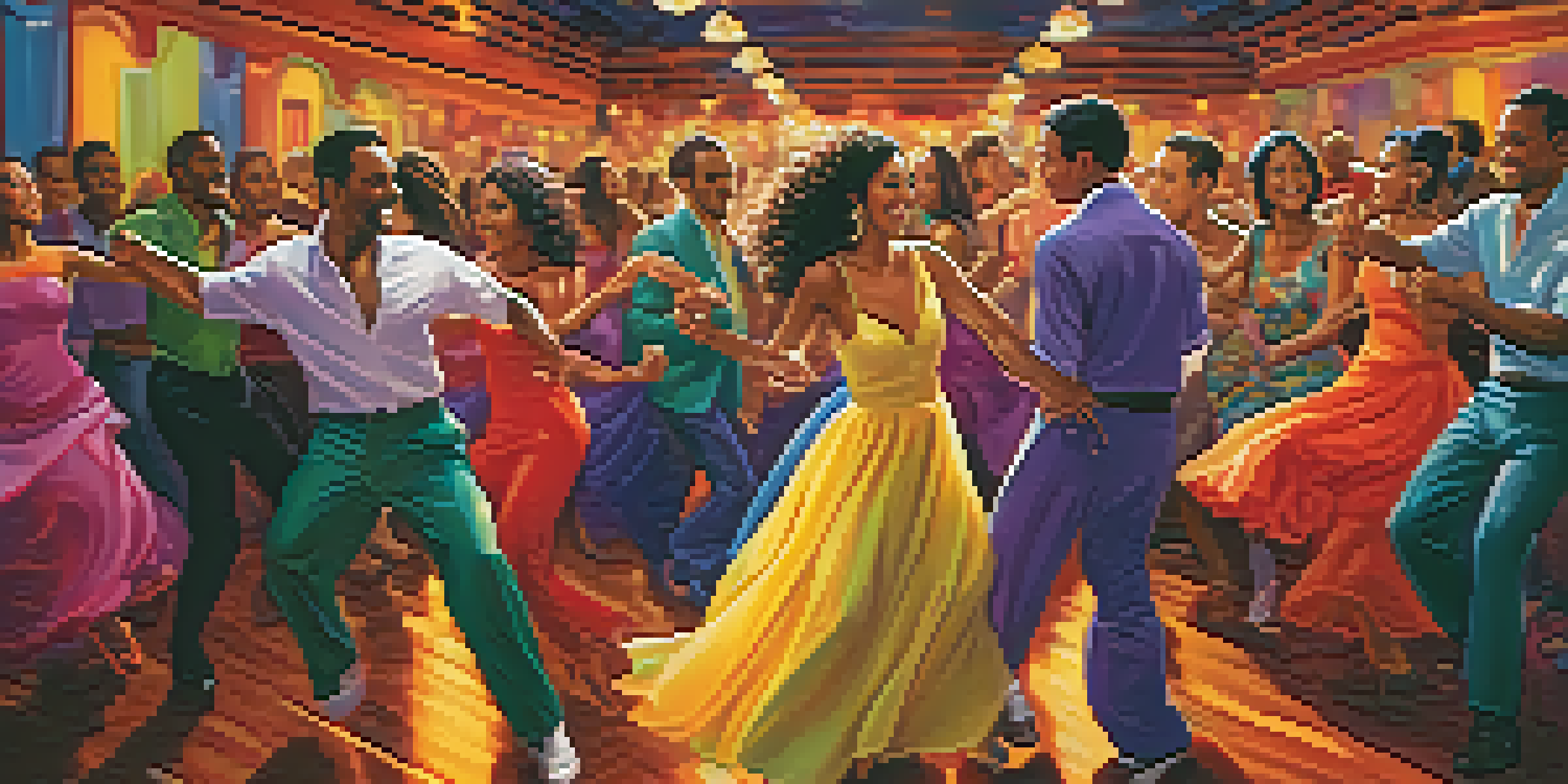The Rhythm of Life: Understanding Music's Role in Dance Forms

The Connection Between Music and Dance
Music and dance are inseparable, each enhancing the other. When you hear a catchy beat, your body instinctively wants to move. This relationship is rooted in human expression, as both art forms communicate feelings and stories without words.
Dance is the hidden language of the soul.
Think about how a lively salsa rhythm can ignite energy on the dance floor, while a slow waltz evokes a sense of romance and grace. This dynamic interplay highlights how music sets the emotional tone and pace for dance, guiding the dancer's movements.
Ultimately, both music and dance are universal languages, transcending cultural barriers. This connection allows people from different backgrounds to come together and share in the joy of movement and melody.
The Role of Rhythm in Dance Styles
Rhythm serves as the foundation for various dance styles, shaping how dancers interpret music. Each dance genre has its own unique rhythm that influences the steps and patterns performed. For instance, hip-hop often features sharp, staccato movements that align with its strong beats.

In contrast, ballet relies on fluidity and grace, reflecting the elegance of classical music. Dancers trained in ballet learn to listen for subtle changes in tempo and dynamics, allowing them to express the music's nuances through their movements.
Music and Dance Are Interconnected
Music and dance enhance each other, creating a universal language that transcends cultural barriers.
This rhythmic relationship not only enriches the dance experience but also enhances the audience's engagement. When dancers synchronize their movements with the rhythm, it creates a captivating performance that resonates deeply with viewers.
Cultural Variations in Dance and Music
Around the world, different cultures have developed unique dance forms that reflect their musical traditions. For example, traditional African dances often celebrate community and life, accompanied by vibrant drumming and call-and-response singing. The rhythm in these pieces is infectious, inviting participation from everyone present.
Music can change the world because it can change people.
Similarly, in Indian classical dance, intricate footwork and hand gestures convey stories while being intricately tied to the rhythm of the accompanying music. The emphasis on timing and precision showcases the deep connection between the two art forms.
These cultural variations highlight how music and dance evolve hand in hand, each influencing the other. By exploring these differences, we gain a richer understanding of human creativity and expression.
The Emotional Impact of Music on Dance
Music has a profound emotional impact on both dancers and audiences. A powerful score can evoke joy, sadness, or nostalgia, enhancing the overall experience of a dance performance. For instance, a haunting melody can prompt dancers to convey deep feelings, resonating with the audience in a powerful way.
Moreover, dancers often draw inspiration from the emotional tone of the music, shaping their movements and expressions accordingly. This emotional interpretation allows for a more authentic performance, as dancers become vessels for the feelings embedded in the music.
Rhythm Shapes Dance Styles
The unique rhythms of different dance genres dictate their movements and techniques, influencing performance and audience engagement.
In this way, music acts as a catalyst for emotional expression in dance, bridging the gap between artist and audience. The synergy created by this connection can leave a lasting impression, making the performance memorable.
How Music Guides Dance Techniques
Music not only influences the style of dance but also the techniques used by dancers. Timing is crucial in dance, and music provides the essential structure for executing steps and movements. For example, dancers learn to count beats, ensuring their movements align perfectly with the music's rhythm.
Additionally, the tempo can dictate the complexity of steps performed. Faster tempos often require quick, sharp movements, while slower tempos allow for more elaborate and fluid techniques. This direct relationship helps dancers hone their skills and adjust their performances to match the music.
As dancers grow more attuned to the music, they develop an innate understanding of how to respond to its cues. This synergy between music and technique ultimately enhances their artistry, enabling them to deliver captivating performances.
The Influence of Technology on Dance and Music
In today's digital age, technology has transformed the way we create and experience dance and music. With the rise of electronic music and digital production, dance styles have evolved to incorporate new sounds and rhythms. This fusion has led to the emergence of genres like electronic dance music (EDM), which inspires innovative dance forms.
Moreover, technology allows dancers to explore various styles from around the world, blending influences to create unique performances. Social media platforms have made it easier for dancers to share their work, gaining inspiration from a global community of artists.
Technology Transforms Dance Creation
Advancements in technology have revolutionized how dance and music are created and experienced, leading to innovative styles and collaborations.
This technological evolution not only expands the creative possibilities but also connects dancers and musicians in ways previously unimaginable. It fosters collaboration and experimentation, pushing the boundaries of what dance can be.
The Future of Music and Dance Interactions
As we look to the future, the relationship between music and dance is bound to evolve further. With advancements in technology, including virtual and augmented reality, we may soon witness immersive dance experiences that blend music, visuals, and movement in unprecedented ways. Imagine stepping into a virtual world where you can dance alongside your favorite performers, guided by their music!
Additionally, as genres continue to blend and evolve, new forms of dance will emerge, reflecting the ever-changing landscape of music. This fusion of styles will encourage creativity and innovation, giving rise to fresh interpretations and expressions.

Ultimately, the rhythm of life will continue to thrive, driven by the powerful connection between music and dance. As we embrace these changes, we can look forward to an exciting future filled with artistic exploration and collaboration.